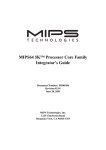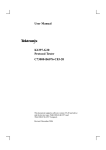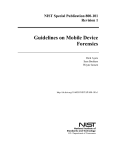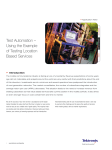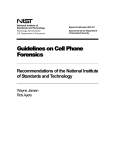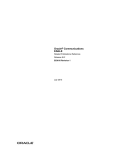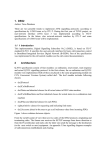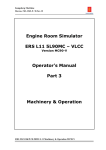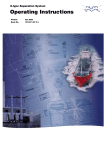Download File
Transcript
▲ Application Note C OM P UT I NG This application note describes protocol tests for the UMTS Iu interface between the Radio Network Controller (RNC) and the Core Network (CN). It is the first in a series of documents on third-generation (3G) wireless networks. Each note addresses one of the new network interfaces and provides guidelines for equipment designers, manufacturers, operators and maintenance personnel to meet the measurement challenges with testing solutions. Examples are given in this document for testing: • Messaging and procedures on the Radio Access Network (RANAP) • Mobile Radio Interface Layer 3 (CC/MM/GPRS MM/GPRS SM) • Traffic channel signaling (AAL2 layer3) • Tunneling (GTP-U). Due to space limitations, only brief descriptions are presented here. Complete detailed information needed to perform these and other tests can be found in the user handbooks for the K1297 and K1205 Protocol Testers and in other training materials. Please contact Tektronix sales support to obtain the most recent information. V I DE O ▲ Protocol Testing in the 3G Wireless Network T E L E C OM Testing the UMTS Iu Interface Testing the UMTS Iu Interface ▲ ▲ Application Note Table of Contents 1. Testing the UMTS Iu Interface INTRODUCTION – THE Iu INTERFACE AND PROTOCOLS ..................................................................................................................................................3 1. Introduction – The Iu Interface and Protocols Application Note All traffic over the Iu interface uses the Asynchronous Transfer Mode (ATM) as the physical transport technology, regardless of the data source. As a result, all data will be segmented into 53-byte ATM-cells and transported 1.1. TRANSPORT PROTOCOLS FOR THE CONTROL PLANE ........................................................................................................................................3 1.2. TRANSPORT PROTOCOLS FOR THE USER PLANE ..............................................................................................................................................3 2. This document describes test applications for the Iu interface as it was defined by 3GPP at the end of 1999 (UMTS Rel. ‘99). Change requests have been 1.3. CONTROL PROTOCOLS FOR CALL CONTROL, SESSION AND MOBILITY MANAGEMENT..........................................................................................4 introduced and new features have been proposed every three months since 1.4. PROTOCOLS FOR USER TRAFFIC ....................................................................................................................................................................4 that definition was adopted, so it is possible that there will be revisions in more MEASUREMENT CHALLENGES AND SOLUTIONS ............................................................................................................................................................4 Monitoring ............................................................................................................................................................................4 2.1.2. Simulation ............................................................................................................................................................................5 2.1.3. Emulation ..............................................................................................................................................................................5 2.1.4. Conformance Testing. ............................................................................................................................................................5 2.2. CONFIGURING THE TEST EQUIPMENT ..............................................................................................................................................................6 Transport protocols for the control plane consist of the SSCS signaling The Iu interface is defined in the 3GPP document series TS25.410-419. Iu is subdivided into two different interfaces: Iu-CS for the circuit switched domain and Iu-PS for the packet switched domain. Figures 1 and 2 show the protocol stacks for each of the Iu interfaces. datagrams. Loss of signaling messages can be detected and retransmitted. SCCP is used to setup specific connections for the connection-oriented communications. Iu normally uses the connection- The protocols can be grouped according to their usage into: oriented mode. Hardware Connection Issues ....................................................................................................................................................6 • transport protocols for control plane 2.2.2. Setting the Operating Parameters ............................................................................................................................................7 • transport protocols for user plane MTP3b handles the routing and traffic management function for upper 2.2.3. Defining Protocol Stacks ........................................................................................................................................................7 • control protocols for call, session, mobility management layer protocols. It delivers messages to the destination point and 2.2.4. Defining Emulation Parameters ................................................................................................................................................8 • protocols for user traffic 2.3.2. manages the load sharing mechanism for the operation. MTP3b is responsible for routing messages within a network with one operator; SCCP routes messages beyond the board of an operator. While the Simulation of AAL2 layer 3 ......................................................................................................................................................9 Radio Network Control Plane Emulation of AAL2 layer 3 ....................................................................................................................................................11 Transport Network Control Plane User Plane Data Services RANAP AAL2L3 RLP SCCP STC CC/MM/GPRS MM/GPRS SM 2.4. TESTING RANAP AND DMTAP ........................................................................................................................................................................12 connections between the RNC and Core Network nodes are shown here User Plane Voice Services as point-to-point, these connections could also be incumbent networks consisting of several interim nodes. TAF AMR Codec Iu UP 2.5. TESTING OF THE GTP-U PROTOCOL ..............................................................................................................................................................13 MTP3-b SSCF-UNI CONCLUSION ..............................................................................................................................................................................................................14 The most logical approach for Iu-PS would be to use the IP protocol stack SSCOP to transport the control signaling information. For this reason, the Internet AAL2 AAL5 APPENDIX I ................................................................................................................................................................................................................15 Engineering Task Force (IETF) has proposed to replace SSCS and MTP3b ATM 4.1. RECOMMENDED DOCUMENTS AND STANDARDS ............................................................................................................................................15 with M3UA and SCTP protocols on top of UDP/IP. Since this protocol stack ▲ 4.2. GLOSSARY ..................................................................................................................................................................................................16 5. ensure the signaling links between network nodes with numbered 2.2.1. 2.3.1. 4. protocols (SSCOP and SSCF) as they are used in broadband networks to different control signaling protocols, enabling both connectionless and 2.3. TESTING AAL2 LAYER 3 ..................................................................................................................................................................................9 3. 1.1. Transport Protocols for the Control Plane recent releases of the standard. 2.1. SELECTING THE APPROACH – MONITORING , SIMULATION, EMULATION, CONFORMANCE ....................................................................................4 2.1.1. asynchronously. is still under development, there are no application tests for it in this Figure 1: Iu-CS protocol stack release of the note. APPENDIX II – UMTS – Entering the Third Generation of Mobile Networks ................................................................................................................20 Radio Network Control Plane Transport Network Control Plane User Plane CC/MM/GPRS MM/GPRS SM IP RANAP Iu UP 1.2. Transport Protocols for the User Plane SCCP MTP3-b M3UA SSCF-NNI SCTP GTP-U UDP SSCOP IP/UDP AAL5 IP AAL5 ATM All signaling traffic for the control plane at the Iu interface is based on AAL type 5. Signaling messages are packet data with variable lengths. However, transport protocols for the user plane use both AAL5 and AAL2 (AAL5 for packet data, AAL2 for circuit-switched transmission). ▲ 2 www.tektronix.com/commtest Figure 2: Iu-PS protocol stacks www.tektronix.com/commtest 3 Testing the UMTS Iu Interface Testing the UMTS Iu Interface ▲ ▲ Application Note Application Note For circuit switched data, the Iu User Plane (Iu-UP) protocol is used to domain (Fax) in order to ensure compatibility with the existing network. IP Interface monitoring can collect data and present results in 2.1.4. Conformance Testing initialize and control the connection Rate Control, Time Alignment and incorporates hundreds protocols used in the Internet and computer world. the following way: Standards allow different manufacturers to develop systems which Handling of Error Events in accordance with the requested QoS • data review for evaluation: The storage of measured data for parameters. Circuit switched data are usually real time transmissions such as voice or video streams. Packet data are transported using GTP-U, UDP and IP protocols in the packet switched domain of the network. In this domain, the Iu-UP 2. Measurement Challenges and Solutions 2.1. Selecting the Approach – Monitoring, Simulation, Emulation, Conformance subsequent review and analysis. The amount of data is an implementation is declared conformant when its capabilities and normally reduced through the filtering of specified events external behavior meet those defined in the referenced standards. (such as abnormal call termination), the use of statistical Conformance testing is the verification process that determines methods or the selection of specific conditions (tracing data at whether a system or an implementation is conformant. While a defined address, tracing a call set-up, etc.). specific conformance tests are defined in UMTS for the air interface (see 3G TS 34.xxx), conformance tests of the remaining UTRAN protocol is in transparent mode and the GTP-U portion of the GTP protocol is responsible for the data transmission. RANAP controls the GTP-U channels – each GTP-U tunnel refers to a single mobile user identified by the tunneling ID. The QoS parameter can be assigned to the GTP-U tunnel. IP is used to address the GTP-U entity. Only four GTP messages are used to ensure data traffic. can interoperate and exchange and handle information. A system or Nearly all measurement situations can be considered in three categories 2.1.2. Simulation with related approaches. Even though there are situations where two or Simulation is the representation or imitation of a process or system more approaches could be applied to the same interface, the first steps by another device. In a test environment, a simulator can be used in in protocol testing should always be to determine the characteristics of place of a network element or a part of the network to produce the system under test and the test objectives. desired conditions. For instance, when testing an RNC, the test interfaces are still dependent upon mutual agreement between manufacturers, operators, and measurement suppliers. equipment can simulate the Core Network behavior, keeping the 1.3. Control Protocols for Call, Session and Mobility Management ➔Do you have a living network that you should not, or are not, allowed to influence? Use the non-intrusive Monitoring approach radio interface layer 3 represents the highest layer control function. It handles the communication between core network and mobile handsets and determines Handover, Location Update, Authentication and Call conformance testing where standardized conditions are Use the Simulation/Emulation approach. applied to the NE. • To substitute missing network elements or parts of a RANAP carries out transmission activities based on the control decisions. equipment? For example, RANAP manages the Radio Access Bearer (RAB), which can Use the Conformance approach weak points of an item can be discovered in the development 2.1.1. Monitoring used to setup, maintain and release user channels for the circuit Monitoring is the process of collecting data from the interface using switched domain. AAL2 layer 3 also handles the layer management either the K1205, a pure monitoring device, or the K1297, which function, which takes care of the transport layer itself. can also perform simulation and emulation. The major objectives for monitoring are: • to get an overall view of the actual performance level 4 www.tektronix.com/commtest process, before introducing it to an operating network. 2.1.3. Emulation Emulation is a higher form of simulation where the behaviors of selected layers of communication protocols are simulated • to determine a possible need for an improvement • to discover the differences between specified/ predicted RLP are used to support data applications within the circuit switched a realistic operating environment for the item under • To save development and installation costs. The strong and mobile user. RANAP initiates, modifies and releases RAB. However, the packet data. Codec is usually not addressed in protocol testing. TAF and network during the development process. Simulation creates development. be seen as a logical connection over the Iu interface related to a specific User traffic protocols are embedded in Codec for voice (AMR) and IP for will perform in the field. Simulations are also used for stimulated? ➔Do you need to verify compatibility with standards or with other 1.4. Protocols for User Traffic element (NE). Normal and abnormal situations are specified environment allows the operator to predict how well the NE ➔Do you have a ‘dead’ node or system that needs to be externally Handling. control of the real physical connection is done by AAL2 layer 3, which is • To get information about the dependability of a network and simulated, and the NE’s ability to cope with the simulated Control protocols for circuit-switched transmission are AAL2 layer 3, mobile radio interface layer 3 (CC/MM/GPRS MM/GPRS SM). The mobile RNC independent of the network. Simulators are used: characteristics • to improve predictions of behavior and potential problems automatically and in conformance with standards. For instance, the simulation of the Iu RANAP is based on an emulation of the corresponding lower layers. While the lower layers are defined to act as specified, the simulated layer can be used to deliberately add faults to test an element’s ability to handle them. www.tektronix.com/commtest 5 Testing the UMTS Iu Interface Testing the UMTS Iu Interface ▲ ▲ Application Note Application Note 2.2.1. Hardware Connection Issues Note: For Monitoring applications, you may proceed to capturing and analyzing data after you have completed the hardware portion of the Securing the proper cables is often a major issue for connecting to tester configuration (Step 2.2.2). the SUT. There are many different connectors and cables that it is nearly impossible to predict what you will need in advance. To be on the safe side, you should assume that none of the standard cables 2.2. Configuring the Test Equipment delivered with the test equipment is the proper one and check to see that you have the necessary adapters to suit each SUT. Adapters for STM1 optical interfaces are provided with the K1297 Figure 3 shows two diagrams that illustrate how to connect the K1297 to overcome the problem for those connections. with the system under test (SUT). Another issue is the mode of operation (single- or multi-mode). Even though the K1297 interface boards can handle both modes, Simulation/Emulation the receiver of the system under test could be overpowered if it Figure 4: Dialog box for physical interface ensure a stable multi-mode connection. ▲ K-1297 ▲ were operated in multi-mode. Power reduction should be inserted to Figure 6: Simulation pipeline and Emulations Scenario Editor the digital data. Thousands of virtual connections can exist in a Tx single ATM physical connection, so it is critical to know the VPI/VCI Rx in order to configure the correct logical links between the test Active Monitoring instrument and the lower layer. Figure 5 shows the window for SUT K-1297 configuring the VPI and VCI. This window also allows the assignment of a protocol stack to each of the logical links. The “Browse” Tx = Transceivers Rx = Receiver Tx Tx function enables the selection of predefined protocol stacks for this Rx Rx purpose. SUT SUT The hardware configuration is now completed, and Monitoring applications can be started. K-1297 Passive Monitoring 2.2.3. Defining Protocol Stacks For Simulation/Emulation applications, the first step is to create a ▲ K-1297 Figure 5: LDS settings for the ATM link 2.2.2. Setting the Operating Parameters Once the equipment is physically connected, parameters for the fiber or electrical connections must be set to conform to the SUT. Figure 4 shows an example of the parameter windows where values Monitoring Ports and options are selected. To view this window, select “Cards K-1297 simulation pipeline. A protocol emulation stack can be defined for each of the pipelines using the “Emulation Scenario Editor” (Figure 6). The emulation protocols are stacked together by logically connecting the upper-layer and lower-layer service access points to represent the protocol instances for each communication connection. Overview” in the main dialog box of the K1297. Detailed descriptions of the parameters are included in the user manual. “Logical Data Source” (LDS) represents the configured physical links which can be connected to the upper layer protocols. In the The most important settings are the “VPI,” virtual path id, and “VCI,” K-1297 virtual channel id, which are used to address the connections for example shown in Figure 6 two protocol emulations are selected and connected, NNISSCS and NNIMTP3b. NNISSCS emulates the ▲ Figure 3: Connecting the K1297 with the system under test (SUT). 6 www.tektronix.com/commtest www.tektronix.com/commtest 7 Testing the UMTS Iu Interface Testing the UMTS Iu Interface ▲ ▲ Application Note Application Note and tested. into specific primitives according to the signaling transport in use, as Detailed descriptions of each of the emulations can be found in the defined in Q.2150.1 and Q.2150.2. This can be the MTP3b for the Iu and directory c:\K1297\hlp. Please refer to these files to configure the Iur interfaces, or the SSCS for the Iub interface. emulations completely and accurately. Depending on test objectives, the K1297 provides either Simulation or Emulation for AAL2 layer 3. The following sections provide guidelines for each approach. 2.3. Testing AAL2 layer 3 This section describes guidelines for AAL2 layer 3 Simulation/Emulation. This protocol layer is responsible for signaling traffic channels on behalf of users such as RANAP. Figure 11 shows the logical structure of AAL2 layer 3 protocol. 2.3.1. Simulation of AAL2 layer 3 The K1297 provides a “Message Building System” to compose correct and incorrect messages and a “Message Sequence Chart” to describe test sequences graphically. A predefined configuration ▲ ▲ Figure 7: Parameters of the SSCP emulation Figure 9: Parameters of the SSCOP emulation Timers need to be defined for SSCS (SSCOP/SSCF) in order to specify the quality of the SSCOP service that is provided to the The Access Link Control Application Part (ALCAP) consists of three parts: set for AAL2 layer 3 Simulation can be loaded by selecting Layer Management, AAL type 2 Signaling, and Signaling Transport “c:\k1297\umtsaal2l3.s.” This configuration is designed to provide Converter (STC). STC converts the AAL2 layer3 messages or primitives an environment for back-to-back testing. upper layers. For example, the timer for keeping the connection alive addresses a critical issue when configuring SSCS for Proving. Defining routing information, such as DPC, OPC and link set, AAL type 2 served user configures MTP3b and provides the signaling information to (Note 2) (Note 2) AAL type 2 served user destinations in the network. SIO values are needed to forward the messages to the upper service access points (SAPs), so an SIO SAP bits are defined. SAP AAL type 2 signaling Primitives and OPC is defined with 14 bits, except in North America where 24 Primitives AAL type 2 signaling messages AAL type 2 signaling SAP SAP Signaling Connection Control Part (SCCP) ensures the connection ▲ Figure 8: Parameters of the MTP3b Service Specific Convergence Sublayer for the Network-NodeInterface, while NNIMTP3b is the broadband MTP layer 3. These emulations contain the AAL2 layer 3 protocol information. Generic Primitives database beyond the board of an operator (for global title Signaling transport converter connectionless services and operates on a database of subsystems SAP Signaling transport subsystems and users must be defined. In order to test RANAP, for Primitives Specific Primitives Signaling transport Primitives example, we need to set the subsystem number (SSN) to 142 (Figure 7). Once these protocols are configured for use, Mobile ▲ Network control protocols can be put on top of this protocol stack 8 www.tektronix.com/commtest SAP Specific Primitives Before SCCP can be put into operation, parameters for supported delivered with pre-configured emulation (Figure 9). Signaling transport converter translation). SCCP emulation provides both connection-oriented and 2.2.4. Defining Emulation Parameters “Parameter View” for each protocol. Most protocol test functions are Generic Primitives for signaling protocol, especially for messages accessing the and users. Parameters for configuring the protocol emulations are listed in the Layer management must be named for each of the MTP3b links. The length of the DPC Primitives SAP SAP upper layer protocols (Figure 8). A destination point code (DPC) This Recommendation (Note 1) Primitives Layer management value must be defined for each SAP depending on the expected Figure 10: Protocol structure of AAL2 layer 3 www.tektronix.com/commtest 9 Testing the UMTS Iu Interface Testing the UMTS Iu Interface ▲ ▲ Application Note Figure 14: Message Sequence Chart When the previous steps are completed, messages for AAL2 layer 3 Now, we are ready to develop test scenarios with the K1297 services for protocols, such as RANAP, and for layer management “Message Sequence Chart” (MSC). An MSC can be created as can be created and modified. Figure 13 displays the window for shown in Figure 14. TC represents the test tool (in this case, the parameter definition of an ESTABLISH REQUEST message. K1297) and IUT means implementation under test. The first Messages for served users are: ▲ Figure 13: Parameter definition for an ESTABLISH REQUEST message ▲ ▲ ▲ Figure 11: Protocols in STK-umts_iu_cs-pool1.pdc Application Note Figure 15: An example of Simulation of AAL2 layer 3 This emulation will be described in greater detail in the next release of this application note. message shown in Figure 14 is the Establish Request message enclosed in an MTP3_UserData_Req primitive. - Establish Request - Establish Confirm A Forth language script is provided with the AAL2 layer 3 Software - Release Request Product. This script is loaded when the system configuration - Release Confirm “umtsaal2l3.s” is opened. The script includes messages that can be sent very easily. In this example the IUT only contains the MTP Messages for layer management are: - Block Request ▲ Figure 12: Messages and primitives emulation without user (AAL2 layer 3). Therefore, after the program sends one of the messages, the MTP emulation of the opposite side responds with UPU message (Figure 15). - Block Confirm You can either open an existing message pool or create a new one. - Unblock Request In addition to the Forth programming environment, which allows the During the creation of a new message pool one appropriate protocol - Unblock Confirm development of Simulation test sequences, the K1297 provides the - Reset Request C-API interface for the programming of test scripts for AAL2 layer 3. stack must be selected and linked with the pool. Figure 11 illustrates the protocols created in a message pool labeled “ STK- umts_iu_cs-pool1.pdc”. - Reset Confirm - Confusion 2.3.2. Emulation of AAL2 layer 3 The Emulation of AAL2 layer 3 is set up to act and react In order to create new messages and new primitives, the underlying automatically to either Layer Management or protocols. For emulation must be connected to the protocol by defining the Once the necessary messages are defined, primitives to the lower property of the protocol (Figure 12). layer protocol should be created for each of the receiving and transmission messages. 10 www.tektronix.com/commtest example, RANAP procedures such as RAB Assignment Request, IuRelease Complete and Iu Bearer Reconfiguration will trigger AAL2 layer 3 emulations for setting up or releasing an AAL2 connection. www.tektronix.com/commtest 11 Testing the UMTS Iu Interface Testing the UMTS Iu Interface ▲ ▲ Application Note Application Note 2.4. Testing RANAP RANAP is much more complex than AAL2 layer 3 and therefore requires more sophisticated testing. Supported RANAP messages and elementary procedures are shown in the following tables. Elementary Procedure Unsuccessful Outcome Response Message Successful Outcome Response Message Initiating Message Iu Release Iu Release Command Iu Release Complete Relocation Preparation Relocation Resource Allocation Relocation Cancel SRNS Context Transfer Relocation Required Relocation Command Relocation Preparation Failure Relocation Request Relocation Cancel Relocation Request Acknowledge Relocation Failure Security Mode Control Data Volume Report Security Mode Command Security Mode Complete Data Volume Report Security Mode Reject Data Volume Report Request CN Information Broadcast CN Information Broadcast Request CN Information Broadcast Confirm CN Information Broadcast Reject Reset Reset Resource Reset Reset Acknowledge Reset Resource Acknowledge SRNS Context Request Figure 16: Packet Generation ▲ ▲ Rest Resource Relocation Cancel Acknowledge SRNS Context Response 2.5. Testing of the GTP-U Protocol Figure 17: Protocol stacks and parameter views two Forth programs, UMTSPGEN.4th and UMTSPCOM.4th, are included for both the transmission and receiving sides. GPRS Tunneling Protocol for User Plane (GTP-U) consists of four messages: Elementary Procedure UMTSPGEN sets the necessary header information for the different Message RAB Release Request RAB Release Request Iu Release Request Relocation Detect Relocation Complete SRNS Data Forwarding Initiation SRNS Context Forwarding from Source RNC to CN Paging Iu Release Request Common ID CN Invoke Trace CN Deactivate Trace Location Reporting Control Location Report Initial UE Message Direct Transfer Overload Control Error Indication Common ID Relocation Detect Relocation Complete protocol layers such as IP, UDP and GTP-U. For a switch to accept the generated packet, the header information must be set in accordance with - Echo Request the switch settings. Some parameters are defined by other signaling - Echo Response protocols in RANAP such as TEID (Tunneling Endpoint ID). - Version Not Supported The Packet Generator is an emulation with extended features like an SRNS Data Forward Command Forward SRNS Context Paging CN Invoke Trace CN Deactivate Trace Location Reporting Control Location Report Initial UE Message Direct Transfer Overload Error Indication - T-PDU application supporting the following protocols: GTP-U (TS 29.060), UDP (RFC 769), IP (RFC 791, 1483, 2225). Data packets can be generated for each of these protocol layers. Figure 17 shows protocol stacks and Echo-Messages check the availability of a link. T-PDU’s carry user data between GTP-U Tunnel Endpoints. The K1297 supports two GTP-U test objectives – you can test the GTP-U protocol elements themselves or test the data services that GTP-U provides. For the first purpose, GTP-U MBS and MSC can be used to simulate the protocol by inserting correct or incorrect messages and timers. These tests follow the same test sequences as the other protocols (see Section 2.3, above). Elementary Procedure RAB Assignment Initiating Message Response Message RAB Assignment Request RAB Assignment Response x N (N>=1) To keep messages as short as possible, RANAP uses the ASN.1 packed Mobility Management, Call Control, GPRS Mobility Management and encoding rules. A byte board is used to separate the message and GPRS Session Management are provided on top of the RANAP. 12 www.tektronix.com/commtest (C:\K1297\config\umts_pgen.s) loads this software for the user (Figure 16). In addition to the message pool and the necessary protocol stack, ▲ information elements. The software tools “Packet Generator” and “Comparator” are provided to test the GTP-U data services. A predefined configuration Figure 18: Result of Packet Generation www.tektronix.com/commtest 13 Testing the UMTS Iu Interface Testing the UMTS Iu Interface ▲ ▲ Application Note corresponding parameter views. PKTGEN can be configured and run for • Monitor and emulation software for 8xSSCOP up to 16 data links by using the configuration tool within the “Parameter • TTCN Compiler for Conformance Test Suites View.” In the example, Forth scripts are used to configure and to start • Executable Test Suites (SSCOP(SSCF), Q.2931, UNI3.1, Q.2763, MTPL3b) 4. Appendix I 4.1 Recommended Documents and Standards: 3G TS 23.110 UMTS Access Stratum Services and Functions 3G TS 25.301 Radio Interface Protocol Architecture UMTSCOMP receives the data, collects statistical information and 3G TS 25.321 Medium Access Control (MAC) Protocol Specification calculates delays. Figure 18 shows the results of a typical test. 3G TS 25.322 Radio Link Control (RLC) Protocol Specification 3G TS 25.323 Packet Data Convergence Protocol (PDCP) protocol 3G TS 25.324 Radio Interface for Broadcast/Multicast Services 3G TS 25.331 Radio Resource Control (RRC) Protocol Specification 3G TS 25.401 UTRAN Overall Description 3G TS 25.410 UTRAN Iu Interface: General Aspects and Principles 3G TS 25.411 UTRAN Iu interface Layer 1 3G TS 25.413 UTRAN Iu Interface: RANAP Signaling 3G TS 25.420 UTRAN Iur Interface: General Aspects and Principles 3G TS 25.423 UTRAN Iur interface RNSAP Signaling 3G TS 25.430 UTRAN Iub Interface: General Aspects and Principles and emulation of IP packet generator and comparator; English documentation; 3G TS 25.433 UTRAN Iub interface NBAP Signaling Requirements (7KK1220-0SCxx) >= V1.0 and ATM-HW 3G TS 29.060 3rd Generation Partnership Project; Technical packet generation for a single data link. • Support for AAL 3/4, AAL 5, STM 4, STM 1 optical/electrical/TP, E3/DS3, E1/DS1, ATM 25.6 interfaces. IETF RFC 2225 Classical IP and ARP over ATM IETF RFC 2460 “Internet Protocol, Version 6 (IPv6) Specification.” ITU-T I.361 B-ISDN ATM layer specification. ITU-T I.363.2 B-ISDN ATM Adaptation Layer Type 2 ITU-T I.363.5 B-ISDN ATM Adaptation Layer Type 5 ITU-T Q.711 Functional description of the Signaling connection The following software packages are available: control part ITU-T Q.712 • UMTS Monitor SW (G20) for Iu-PS user plane interface; incl.: GTP-U (TS29.060) 3. Conclusion and IP as well as underlying protocols UDP/IP and IP over ATM; English documentation; Required basic package >=V1.0 (7KK1220-0SCxx) and ATM-HW The K1297 Protocol Tester is a powerful tool for the design, development and deployment of new 3G networks. The K1297 is a comprehensive solution, • UMTS Test SW (G20) for Iu control-plane; incl.: Emulations of SSCOP, MTP3B, adding simulation and emulation capabilities and an enhanced graphical user SCCP emulation and simulation of AAL2L3(Q.2630.1, Q.2150.2), interface to the extensive monitoring functions of its predecessor, the K1205. RANAP(TS25.413) and Mobile Radio Layer 3 (TS24.008); English documentation; The K1297 is compact and configurable to help you meet a variety of Required basic package >= V1.0 (7KK1220-0SCxx) and ATM-HW measurement challenges with ease, including: • protocol functional tests • node simulations, where the entire protocol stack is emulated/simulated, including the user plane. • UMTS Test SW (G20) for Iu-PS user plane; incl.: simulation of GTP-U (TS29.060) Service (GPRS); GPRS Tunneling Protocol (GTP) across For additional information please also access our web site at www.tektronix.com/commtest. ITU-T Q.713 Signaling connection control part formats and codes ITU-T Q.714 Signaling connection control part procedures ITU-T Q.715 Signaling connection control part user guide ITU-T Q.716 Signaling Connection Control Part (SCCP) performance ITU-T Q.2100 B-ISDN Signaling ATM Adaptation Layer (SAAL) overview description. ITU-T Q.2110 protocol testing applications. All bundles include: • Monitoring ITU-T Q.2130 at the User Network Interface (SSCF at UNI) ITU-T Q.2140 interfaces will follow in the near future. This document is also available at our • Emulation web site (www.tektronix.com), along with updates and related documents. • Sample scripts for message sequences, message pools and predefined Tektronix is committed to the most advanced test solutions for mobile • Simulation Base software with Emulation Scenario Editor (ESE), ETSI GSM 12.04 Digital cellular telecommunication system (Phase 2); G. Sidebottom et al, “SS7 MTP3-User Adaptation Layer networks. As mobile networks continue to evolve through GPRS, UMTS and (M3UA draft-ietf-sigtran-m3ua-02.txt (Work In Progress), cdma2000, we will keep you in the forefront with the latest testing products IETF, 10 March 2000 Message Sequence Chart (MSC), Message Building System (MBS), and methods. PFE-Forth based interpreted scripting language We welcome your comments and suggestions for improving these documents draft-ieft-sigtran-sctp-v0.txt (Work In Progress), IETF, and your ideas for developing other tools to help you meet the measurement September 1999 To address the new ATM features in the UMTS, K1297/ATM Software includes: • Monitor and simulation software for UNI (Q.2931 CS2.1, ATMF UNI3.1, ATMF UNI4.0) • Monitor and simulation software for NNI (Q.2761 - Q.2764 CS2.1, B-ICI 2.1) 14 www.tektronix.com/commtest challenges of new wireless systems. Interface (SSCF AT NNI). ITU-T Q.2150.1 IETF SCTP AAL type 2 Signaling Transport Converter on Broadband MTP ITU-T Q.2150.2 AAL Type 2 Signaling Transport Converter on SSCOP (Draft) Performance data measurements IETF M3UA B-ISDN ATM adaptation layer - Service Specific Coordination Function for Signaling at the Network Node profiles) (ETR/ATM-1002) defined by 3GPP in 1999. Updates and solutions for the new Iub and Iur B-ISDN Signaling ATM Adaptation Layer - Service Specific Coordination Function for Support of Signaling Advanced Testing Methods (ATM); Tutorial on protocol conformance testing (Especially OSI standards and engineer who is interested in solutions for the UMTS Iu interface as it was • Protocol simulation emulation stacks ETSI ETR 021 B-ISDN ATM Adaptation Layer - Service Specific Connection Oriented Protocol (SSCOP). the Gn and Gp Interface This first release of the application note presents guidelines for the test Definition and function of Signaling connection control part messages Specification Group Core Network; General Packet Radio • node tests, where all messages belonging to a message group can be collected. The K1297 features programming flexibility and a common platform for all Appendix I ITU-T Q.2210 Message transfer part level 3 functions and messages using the services of ITU-T Recommendation Q.2140. ITU-T Q.2630.1 AAL type 2 Signaling Protocol (Capability Set 1) R. Stewart et al, “Simple Control Transmission Protocol,” IETF RFC 791 Internet Protocol IETF RFC 768 User Datagram Protocol IETF RFC 1483 Multi Protocol Encapsulation over ATM Adaptation Layer 5 www.tektronix.com/commtest 15 Testing the UMTS Iu Interface Testing the UMTS Iu Interface ▲ ▲ Appendix I 4.2. Glossary CDMA2000 3rd generation Code Division Multiple Access GTP GPRS Tunneling Protocol Mbps Megabits per second Appendix I 1G First Generation CC Call Management protocols GTP-C GTP Control MBS Message Building System 2G Second Generation CN Core Network GTP-U GTP User MC Multi-Carrier 3G Third Generation CRNC Controlling RNC (Radio Network Controller) HLR Home Location Register MC-CDMA Multi-Carrier CDMA 3GPP Third Generation Partnership Project (of ETSI) CS Circuit Switched HO/HoV Handover MCE Multi-protocol Encapsulation 8PSK Eight phase Shift Keying CS-CN Circuit Switched Core Network HSCSD High Speed Circuit Switched Data ME Mobile Equipment AAL ATM Adaptation Layer CSE CAMEL Service Environment ICO Intermediate Circular Orbits MM Mobility Management (protocols) AAL2 ATM Adaptation Layer Type 2 CT Conformance Test IETF Internet Engineering Task Force MSC Mobile Services Switching Center, Message Sequence AAL5 ATM Adaptation Layer Type 5 D-AMPS Digital AMPS IMEI International Mobile Equipment Identification AC Authentication Center DCH Dedicated Channel IMT-2000 International Mobile Telecommunications 2000 MSS Mobile Satellite System ALCAP Access Link Control Application Part DECT Digital Enhanced Cordless Telephone IMUN International Mobile User Number MT Mobile Telephone AMPS Advanced Mobile Phone Service DL Downlink IN Intelligent Network MTP Message Transfer Part AMR Adaptive Multi-Rate (speech codec) DPC Destination Point Code IP Internet Protocol MTP3b Message Transfer Part level 3 (broadband) for Q.2140 ANSI T1 Standards Committee T1 Telecommunication of the DRNC Drift Radio Network Controller IPv4 IP version 4 NAS Non Access Stratum DRNS Drift Radio Network Subsystem IPv6 IP version 6 NBAP Node B Application Protocol DTE Data Terminal Equipment IS-95 Interim Standard ´95 NE Network Elements EDGE Enhanced Data Rates for GSM Evolution ISDN Integrated Services Digital Network NMT Nordic Mobile Telephone EFR Enhanced Full Rate (speech codec) ISP Internet Service Provider NNI Network-Node Interface EIR Equipment Identity Register ISUP ISDN User Part Node B UMTS Base Station ESE Emulation Scenario Editor ITU International Telecommunication Union NRT Non-Real Time ETSI European Telecommunication Standards Institute Iu UTRAN interface between RNC and CN NSS Network Switching Subsystem FDD Frequency Division Duplex Iub UTRAN interface between Node B and RNC O&M Operation and Maintenance FDMA Frequency Division Multiple Access Iu-CS UTRAN interface between RNC and the circuit switched OSA Open Service Architecture FEC Forward Error Correction domain of the CN OSS Operation Subsystem FER Frame Error Rate UTRAN interface between RNC and the packet switched PDC Personal Digital Communication domain of the CN PDCP Packet Data Convergence Protocol Iur UTRAN interface between two RNCs PDH Plesiochronous Digital Hierarchy IUT Implementation Under Test PDN Packet Data Network IWF Interworking Function PDU Protocol Data Unit kbps kilobits per second PLMN Public Land Mobile Network LLC Relay Logical Link Control - Relay PMR Private Mobile Radio M3UA MTP3 User Adaptation PS Packet Switched MAC Medium Access Control PS-CN Public Switched Core Network MAP Mobile Application Part PSTN Public Switched Telephone Network American National Standards Institute ARIB/TTC Association of Radio Industries and Business/Telecommunication Technology Committee ASN.1 Abstract Syntax Notation One ATM Asynchronous Transfer Mode AuC Authentication Center BEC Backward Error Correction BMC Broadcast/Multicast Control BSC Base Station Controller BSS Base Station Subsystem BTS Base Transceiver Station CAMEL Customized Application for Mobile Enhanced Logic CAP GGSN Gateway GPRS Support Node GMM GPRS Mobility Management (protocols) CAMEL Application Part CATT China Academy of Telecommunication Technology CBR Constant Bit Rate (data stream) CC Call Control CCITT Comité Consultatif International Téléphonique et GMSC Gateway MSC GMSK Gaussian Minimum Shift Keying GPRS Telecommunication CCS7 Common Control Signaling System No 7 CDMA Code Division Multiple Access 16 www.tektronix.com/commtest General Packet Radio Service GSM Global System for Mobile Communication GSM-R GSM Railway gsmSCF GSM Service Control Function gsmSSF GSM Service Switching Function Iu-PS Chart www.tektronix.com/commtest 17 Testing the UMTS Iu Interface Testing the UMTS Iu Interface ▲ ▲ Appendix I QoS Quality of Service (ATM network channels) TACS Total Access Communication System VBR Variable Bit Rate (data stream) QPSK Quadrature Phase Shift Keying (or, Quaternary Phase TAF Terminal Adaptation Functions VHE Virtual Home Environment Shift Keying) TC Transcoder VLR Visitor Location Register RAB Radio Access Bearer TD-CDMA Time Division-Code Division Multiple Access VMSC Visited MSC RAN Radio Access Network TDD Time Division Duplex WCDMA Wide band Code Division Multiple Access RANAP Radio Access Network Application Part TDMA Time Division Multiple Access WLL Wireless Local Loop RLC Radio Link Control TD-SCDMA Time Division - Synchronous CDMA RLP Radio Link Protocol TEID Tunneling Endpoint ID RNC Radio Network Controller TETRA TErrestrial Trunked Radio Access RNS Radio Network Subsystem TIA Telecommunications Industry Association RNSAP Radio Network Subsystem Application Part TN-CP Transport Network-Control Plane RNTI Radio Network Temporary Identity TPC Transmission Power Control RR Radio Resource TRAU Transcoder and Rate Adaptation Unit RRC Radio Resource Control TS Technical Specification RRM Radio Resource Management TTA Telecommunications Technology Association RTT Radio Transmission Technology U MSC U MSC Mobile Switching Center (the integration of the SAAL Signaling ATM Adaptation Layer MSC and the SGSN in one physical entity (UMTS+MSC = SCCP Signaling Connection Control Part UMSC) SCTP Simple Control Transmission Protocol U MSC-CS U MSC Circuit Switched SDH Synchronous Digital Hierarchy U MSC-PS U MSC Packed Switched SDO Standard Development Organization U SSD Unstructured Supplementary Service Data SGSN Serving GPRS Support Node UDP User Datagram Protocol SIM Subscriber Identity Module UE User Equipment SM Session Management protocols UICC UMTS IC Card SRNC Serving Radio Network Controller UL Uplink SRNS Serving Radio Network Subsystem Um GSM Air Interface SS7 = CCS7 (Common Control Signaling System No. 7) UMTS Universal Mobile Telecommunication System SSCF Service Specific Coordination Function UNI User-Network Interface SSCOP Service Specific Connection Oriented Protocol UP User Plane SSF Service Switching Function USIM UMTS Subscriber Identity Module STC Signaling Transport Converter UTRA UMTS Terrestrial Radio Access STM1 Synchronous Transport Module - level 1 UTRAN UMTS Terrestrial Radio Access Network SUT System Under Test Uu UMTS Air interface SW Software UWC-136 Universal Wireless Communication 18 www.tektronix.com/commtest Appendix I www.tektronix.com/commtest 19 UMTS – Entering the Third Generation of Mobile Networks UMTS – Entering the Third Generation of Mobile Networks ▲ ▲ Appendix II 5. Appendix II – Introduction to UMTS defines enhancements and transitions for existing GSM networks. Another newly defined UTRA mode - Multi Carrier (MC) - is expected to Appendix II The Iu, Iub and Iur interfaces are based on ATM transmission principles. establish compatibility between UMTS and cdma2000. UMTS – Entering the Third Generation of Mobile Networks The Public Land Mobile Network (PLMN) described in UMTS Rel. ´99 incorporates three major categories of network elements: • GSM Phase 1/2 core network elements: MSC,VLR, HLR, AC and EIR The Universal Mobile Telecommunication System (UMTS) is one of the most The Radio Network Controller (RNC) enables autonomous Radio Resource Implementation - New Network Elements and Interfaces (CSE) Generation of Mobile Networks. UMTS allows many more applications to be introduced to a worldwide base of users and provides a vital link between UMTS standardization and development is moving very quickly, but several • UMTS specific modifications and enhancements, particularly UTRAN today's multiple GSM systems and the ultimate single worldwide standard for The GSM Phase 1/2 PLMN consists of 3 subsystems: the Base Station all mobile telecommunications (IMT-2000). The new network also addresses Subsystem (BSS), the Network Switching Subsystem (NSS) and the Operation the growing demand of mobile and Internet applications for new capacity in the Subsystem (OSS). The BSS consists of the Base Station Controller (BSC), Base overcrowded mobile communications sky. UMTS increases transmission speed Transceiver Station (BTS) and Transcoding & Rate Adaptation Unit (TRAU). The to 2 Megabits/s per mobile user and establishes a global roaming standard. Station Controller (BSC), providing central control for the Radio Network System (RNS) elements (RNC and Node Bs). • GSM Phase 2+ enhancements: GPRS (SGSN and GGSN) and CAMEL significant advances in the evolution of telecommunications into the 3rd Management by UTRAN. It performs the same functions as the GSM Base NSS consists of Mobile Services switching Center (MSC), Visitor Location steps must be taken before we can enjoy global mobility at the remarkable new The RNC handles protocol exchanges between Iu, Iur, and Iub interfaces and is speeds. New network elements are being developed and adopted, while responsible for centralized Operation & Maintenance for the total RNS with existing network nodes are being extensively modified. All of these access to the Operation SubSystem (OSS). Because the interfaces are ATM- developments require the creation and integration of new software and based, the RNC switches ATM cells between them. The user's circuit-switched hardware modules that will then be manufactured, deployed, commissioned and packet switched data coming from Iu-CS and Iu-PS interfaces are and operated. multiplexed together for multimedia transmission via Iur, Iub, and Uu interfaces to and from the User Equipment (UE). Register (VLR), Home Location Register (HLR), Equipment Identity Register (EIR) and the Authentication Center (AC). The MSC provides functions such as The UMTS standard can be seen as an extension of existing networks. Two new switching, signaling, Paging, and Inter-MSC Handover. The OSS consists of network elements are introduced in UTRAN, Radio Network Controller (RNC) The RNC uses the Iur to autonomously handle 100% of the Radio Resource Operation & Maintenance Centers (OMC), which are used for remote and and Node B. UTRAN is subdivided into single Radio Network Systems (RNS), Management (RRM), eliminating that burden from the Core Network. Serving centralized Operation, Administration and Maintenance tasks. where each RNS is controlled by a Radio Network Controller (RNC). The RNC is control functions such as Admission, RRC connection to the UE, Congestion reach global acceptance, 3GPP is introducing UMTS in Phases and Annual UMTS (Rel. '99) incorporates enhanced GSM Phase 2+ Core Networks as a connected to a set of Node B elements, each of which can serve one or several and Handover/Macro Diversity are managed entirely by a single Serving RNC Releases. The first release (UMTS Rel. '99), introduced in December of 1999, platform, creating an entirely new network and protocol architecture with GPRS cells. (SRNC). If another RNC is involved in the active connection through an Inter- Standardization UMTS is being developed by 3GPP (Third Generation Partnership Project), a joint venture of several Standards Development Organizations - ETSI (Europe), ARIB/TTC (Japan), ANSI T1 (USA), TTA (South Korea) and CWTS (China). To (General Packet Radio Services) and CAMEL (Customized Applications for Mobile network Enhanced Logic). The new networks will be AUC GMSC PSTN Gi C E INTERNET GGSN H landscape, enabling network operators to enjoy the Gc HLR Gn D other PLMN Gr Gp G MSC F MSC E implementation. Gf VLR SGSN Iu-PS Iu-CS Iur RNS RNC Abis Iub The most significant change in Rel. '99 is the new RNS RNC Node B Iub Node B Node B Abis Uu Mobile Phones Handheld Mobile Devices Node B (CRNC) is used to define the RNC that controls Node Bs. completely new designs. RNC will become the replacement for BSC and Node B fulfills nearly the same functionality as a BTS. GSM and GPRS networks will Node B is the physical unit for radio transmission/reception with one or more be extended and new services will be integrated into an overall network that cells. A single Node B can support both FDD and TDD modes, and it can be contains both existing interfaces such as A, Gb, Abis and new interfaces that co-located with GSM BTS to reduce implementation costs. Node B connects include Iu, Iub and Iur. with the UE via the W-CDMA Uu radio interface and with the RNC via the Iub BTS UMTS defines four new open interfaces: UMTS Terrestrial Radio Access Network (UTRAN) BSC (UTRA), a W-CDMA radio interface for land based BTS responsible for the allocation of Code resources. The term Controlling RNC ATM based interface. Node B is the ATM termination point. that includes the UMTS Terrestrial Radio Access BTS adopt the UMTS requirement, but RNC, Node B and the handsets must be Gb Iu-PS BSC Existing network elements, such as MSC, SGSN and HLR, can be extended to Gs Iu-CS A improved cost efficiency of UMTS while protecting their 2G investments and reducing the risks of EIR VLR installed as islands within the GSM Phase 1/2 RNC Soft Handover, it is declared a Drift RNC (DRNC). The DRNC is only BTS communications. UTRA supports Time Division • Uu: User Equipment(UE) to Node B (UTRA, the UMTS W-CDMA air interface) • Iu: RNC to GSM Phase 2+ Core Network interface (MSC/VLR or SGSN) interface. It measures the quality and strength of the connection and determines the Frame Error Rate (FER), transmitting these data to the RNC as a Measurement Report for Handover and Macro Diversity Combining.The Node B Duplex (TDD) and Frequency Division Duplex (FDD). Iu-CS for circuit switched data The TDD mode is optimized for public Micro & Pico Iu-PS for packet switched data. cells and unlicensed cordless applications. The The main task of Node B is the conversion of data to/from the Uu radio • Iub: RNC to Node B interface is also responsible for the FDD Softer Handover. This Micro Diversity combining is carried out independently, eliminating the need for additional transmission capacity in the Iub. FDD mode is optimized for wide area coverage, i.e. ▲ Figure 1: Overview of a UMTS network public Macro & Micro cells. Both modes offer flexible and dynamic data rates up to 2 Mbit/s. 20 www.tektronix.com/commtest • Iur: RNC to RNC interface; not comparable to any interface in GSM The Node B also participates in Power Control as it enables the UE to adjust its www.tektronix.com/commtest 21 UMTS – Entering the Third Generation of Mobile Networks ▲ Appendix II power using DL TPC commands via the Inner Loop Power Control on the basis landscape to full coverage during the next 10 years. Therefore, cross network of UL Transmit Power Control TPC information. The predefined values for Inner services must be managed by signaling protocols along with the UMTS specific Loop Power Control are achieved from the RNC via Outer Loop Power Control. services. For example, signaling must handle UMTS originated and GSM terminated calls without interrupts. Protocol interactions across the networks and inter-system handover are challenging tasks in the testing of mobility and New Technology - New Testing Challenges call control. From the technology standpoint, testing UMTS interfaces presents a new set of During the life cycle of UMTS, one of the most important aspects is quality challenges. UMTS networks are based on the integration of ATM, IP and management. Protocol Testers such as the K1297 help to shorten the Mobile Network technologies. ATM brings "unlimited" bandwidth and QoS development time, increase product quality and maintain the UMTS network. limits, IP brings "unlimited" coverage, and Mobile Network brings "unlimited" These instruments are essential partners for manufacturers and operators who mobility. In addition, UMTS will use CDMA as the air interface technology, are phasing into 3G mobile networks. introducing different signaling procedures and different control signal levels than those found in GSM and GPRS networks. The K1297 Protocol Tester always refers to standardized UMTS interfaces. It treats the System Under Test (SUT), whether a single network node or a subAlmost every ATM transmission speed from two Megabits/s up to STM4 (622 network, as if it were a black box. In both "Monitoring" and "Simulation & Megabits/s) is defined for UMTS. Moreover, ATM has been designed to support Emulation" modes, the tester compares the digital data streams that appear at these speeds at specified quality of service (QoS) levels for traffic with the interfaces with those defined in the standard. guaranteed delays, losses and error rates. Constant bit rate (CBR) and variable bit rate (VBR) data streams are assigned to VPI/VCI virtual channels to achieve the required bandwidth. It is possible for a single connection to occupy the entire physical bandwidth of a virtual channel, or even require hundreds or thousands of virtual channels with smaller bandwidths. ATM Adaptive Layers AAL2 and AAL5 protocols are the assembly and reassembly mechanisms used within UMTS networks. AAL5 is primarily used for packet data connections and signaling traffic, while AAL2 with its subchannels is used for voice and real time applications. Another issue for testing is that AAL2 and AAL5 connections can occur simultaneously in the same physical link. While ATM provides virtual channels with QoS using either AAL2 or AAL5 protocols; IP distributes almost all applications over the network using hundreds of different application protocols. From the testing point of view, IP (at least IPv4) doesn't care about bandwidth or transmission quality. IP routes the carried information to each destination independently, regardless of where it is in the world. The challenges of testing IP are the large amount of data and the variety of application protocols that it carries. The UMTS enabled network is being grown from islands within the GSM 22 www.tektronix.com/commtest tektronix.com/commtest ASEAN Countries (65) 356-3900 Australia & New Zealand 61 (2) 9888-0100 Austria, Central Eastern Europe, Greece, Turkey, Malta & Cyprus +43 2236 8092 0 Belgium +32 (2) 715 89 70 Brazil & South America 55 (11) 3741-8360 Canada 1 (800) 661-5625 Denmark +45 (44) 850 700 Finland +358 (9) 4783 400 France & North Africa +33 1 69 86 81 81 Germany +49 (221) 94 77 400 Hong Kong (852) 2585-6688 India (91) 80-2275577 Italy +39 (2) 25086 501 Japan (Sony/Tektronix Corporation) 81 (3) 3448-3111 Mexico, Central America & Caribbean 52 (5) 666-6333 The Netherlands +31 23 56 95555 Norway +47 22 07 07 00 People’s Republic of China 86 (10) 6235 1230 Republic of Korea 82 (2) 528-5299 South Africa (27 11) 651-5222 Spain & Portugal +34 91 372 6000 Sweden +46 8 477 65 00 Switzerland +41 (41) 729 36 40 Taiwan 886 (2) 2722-9622 United Kingdom & Eire +44 (0)1344 392000 USA 1 (800) 426-2200 From other areas, contact: Tektronix, Inc. Export Sales, P.O. Box 500, M/S 50-255 Beaverton, Oregon 97077-0001, USA 1 (503) 627-6877 Worldwide Web: for the most up-to-date product information visit our web site at: www.tektronix.com/commtest Copyright © 2000, Tektronix, Inc. All rights reserved. Tektronix products are covered by U.S. and foreign patents, issued and pending. Information in this publication supersedes that in all previously published material. Specification and price change privileges reserved. TEKTRONIX and TEK are registered trademarks of Tektronix, Inc. All other trade names referenced are the service marks, trademarks or registered trademarks of their respective companies. 11/00 BC/BT 2FW-14252-0














